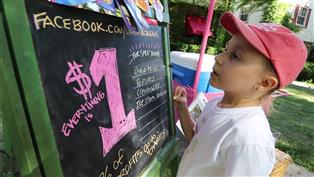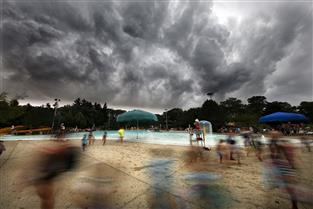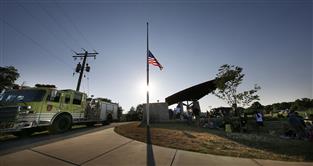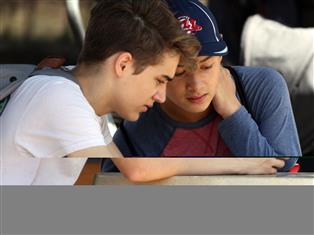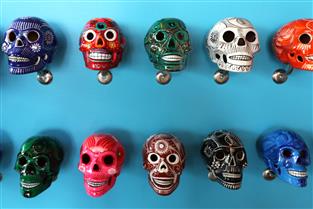A behind-the-scenes peek at the Milwaukee County Zoo
Animals aren't the only thing the Milwaukee County Zoo needs to maintain. With more than 115 full time staff, 500 seasonal workers and an annual attendance over 1,000,000, the zoo gets a lot of work done behind the scenes to keep itself operational.
With spring around the corner, employees in two departments in particular are gearing up for the warmer months, which see the largest zoo attendance: the horticulturalists and the train yard staff. Both groups work year-round.
Maintaining the trains
Maintaining two diesel and two steam powered trains for near round-the-clock summer work is a four-month process for zoo mechanics, who work on other projects when they are not repairing the trains.
The trains, which are decades old, have had their engines rebuilt, chassis worked on and constant improvements added to them to keep them safe and running. The zoo's oldest train, the black and orange 1958, has a completely different diesel engine.
While normally the trains would be running by now, cold weather and snow have stymied their launch dates. The mechanics, however, are busy with fabrication work and preparing the trains for summer.
One such mechanic is Norman Kitchenakow, who started working at the zoo when he was 16. He is currently working on a train car design of his own, a gravel-dispensing car that would be the zoo's first fully-fabricated car. Kitchenakow's design would save the zoo from borrowing a gravel car from the Wisconsin Dells.
Before warm weather hits, he plans on installing new hydraulic lines and wheels on the red and white train, which he painted. When not repairing or running the diesel trains, he fabricates cages and other zoo facilities.
He is currently working on a shift cage for snow leopards, metal manure pits and shift feeders for small mammals. He is also a heavy equipment operator for the zoo, driving large vehicles and helping the zoo plow. He takes his fabrication and machine work home with him, customizing his green Harley motorcycle.
"I love the diversity of my job and the fact that I'm allowed to be creative," Kitchenakow said. "I can have pride in my work. It's a totally different work environment."
Working alongside Kitchenakow is Ken Ristow, whose job is to look after the two steam-powered engines. Having a passion for steam trains since he was a child, Ristow begun work on them at the Baraboo Rail Museum as a seasonal worker in the early 1990s. He worked five days a week maintaining trains up to a century old. He got his engineer's license at age 26 and worked as an educator until 1999, when he started working on the zoo's trains.
"It's more like a pet that you have at your house because you have to constantly feed it, brush its fur, take care of it, maintain its litter box," he said. "Without your care for your pet, your pet's going to suffer and without us taking care of the locomotives, they're not going to run."
Horticulture and habitat
Tucked away in the zoo next to the train machine shop are three green houses. Inside the greenhouses are plants grown for myriad tasks, including creating an environment for the animals, supplementing animals' diets, creating displays and adding to concessions.
Over 35,000 perennials are grown annually in the greenhouse and hundreds of plants are maintained by a small team of horticulturalists and arborists.
During the winter months, most of the herbal work is concentrated on maintaining the aviary and ape department. When Zoo Horticulturalist Ann Hackbarth creates the bird's environment, she has to get in their heads. Sometimes the aviary will get a nervous new bird and she'll have to give it more foliar coverage.
When creating paths for the ducks, she said she had to think like a duck and create winding paths for them.
"Just like in married life, you put a pair of birds together, they can get tired of their spouse and need a space to hide."
Hackbarth said birds are some of the most destructive animals to their environment, so she and other horticulturalists grow plants specifically for the birds to rip up. The plants grow faster and are much cheaper than the foliage that comprises the birds' habitat.
The horticulturalists also must keep in mind which plants are poisonous to the birds and have a multi-page lists of banned plants. While keeping that in mind, they must also try their best to reproduce the birds' native environments with plants limited by growing conditions, price and rarity.
"Just because it would work in Australia, doesn't mean it would work in Milwaukee in this 10 by 30 foot area that has a skylight that half the time is covered in snow," Hackbarth said.
Working the three greenhouses is Tricia Summers. Her job is to maintain growing conditions, keep track of all plant stock, help with arrangements and plan for all the bedding work.
The major floral arrangements, including the zoo's logo, the bed in the parking lot and the arrangement next to the sea lions, must be planned out nearly a year in advance. This year's paw prints were designed and ordered last August. Next year's arrangement will need to be ordered and ready before September this year.
Between planning major arrangements, animal environments, herbs for the concessions stand and other beds around the zoo, Summers must prepare arrangements for the zoo's over 100 annual events, including Easter, Christmas and Halloween.
"The zoo keepers say that they're a seven-day operation but we say we're a seven-day operation too," she said. "We need dedicated, conscientious people here to check every single plant."
More from News and Features
- Anodyne Coffee plans to open location in Wauwatosa Village
- Wauwatosa Meetings: Aug. 4
- Video: Wauwatosa girl's curbside ice cream stand raises money for the hungry
- Wauwatosa News and Notes: Hands-only CPR training offered; Firefly Art Fair is Aug. 6-7
- Wauwatosa Ask Now: Why are there barriers and fencing along the North Avenue bridges over the Menomonee River?
- Mystery Photo Contest: July 28
- Wauwatosa gears up for National Night Out event, this year at the zoo
- Election 2016: Wisconsin's 4th District candidates weigh in
- Wauwatosa's Luther Manor residents share smiles through flower delivery
- Wauwatosa Police Report: July 17-23





.jpg&resize=660*421)



